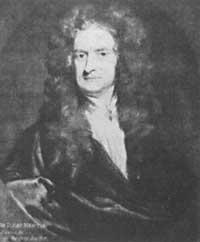Isaac Newton
Elhuyar Fundazioa
English scientist and mathematician born at Woolsthorpe in Lincolnshire on 25 December 1642. His father died when he was interned and at age three his mother remarried. The child was left in the hands of grandparents. They sent to school and there he took care of the mechanisms he invented and the problems of the world around him.
As a young man he was taken to cultivate his mother's land, but there was nothing good there and his uncle believed he could be wise sent him to the University of Cambridge. In Cambridge he began to study in 1660 and in 1665 he had already obtained his doctorate.
With the plague dominated by London, he retired to his mother's hamlet to protect Newton from danger. In the field of mathematics he was working on binomial theorem, but in his mother's grounds he began a very important topic. Seeing that an apple falls to the ground, the force that caused the fall of the apple and the force that kept the Moon in its orbit seemed that they could have relationship.

In the Middle Ages, following the ideas of Aristotle, it was thought that terrestrial and celestial objects were governed above all over the movement by completely different natural laws. The relationship between the apple and the moon with the same law was therefore a brave idea. Newton claimed that theoretically the falling velocity of the object was directly proportional to the gravitational force and that this force was both inversely proportional to the square of the object's distance to the center of the Earth.
Newton calculated the falling velocity of the Moon by comparing the gravitational force exerted by the Earth on its satellite with the gravitational force exerted on the Earth's surface. His calculations did not exactly coincide with those measured in the observations of the time and Newton abandoned for fifteen years the problem of gravitation.
Between 1656 and 1666 it is immersed in optics problems. As the ray of light passed through a groove through a prism, he saw the refracted light on the screen of the dark room. It was a collection of colored bands, a spectrum formed by different bands from red to purple (as in the rainbow). As the spectrum passed by another reverse oriented prism, it again obtained white light on the screen.
In 1669 the professor of mathematics of Cambridge resigned to leave the chair of Newton. In 1672 he was a member of the Royal Society, but with President Robert Hooke it was never solved.
Newton and Leibniz developed separately and at the same time a mathematical calculation. Over the years it emerged between the two somewhat irreparable, as one was English and another German.
Based on light essays by Newton, he discovered his theories about the nature of light. The telescopes of that time were refractive and could hardly be improved by the phenomenon called chromatic aberration. Newton, however, invented and improved the reflection telescope.
Between 1680 and 1690 he was again responsible for the recording analyzed in his youth. Philosophiae Naturalis Principia Mathematica (Mathematical Principles of Natural Philosophy) began writing about the motion of the earth, planets and bodies, considered one of the most outstanding of science ever realized in this world. In it, Newton collected Galileo's discoveries about movement into three fundamental principles.
The first principle pointed out that the motionless body remains motionless and the moving one continues to move at constant speed unless external forces participate.
The second principle relates force to the mass of the object and its acceleration. Therefore, for the first time the body mass (amount of inertia it contained) was separated from its weight (gravitational force exerted on the body).
The third and last principle states that each action carries with it the same reaction in the opposite direction.
Of these three principles, Newton calculated the gravitational force between Earth and the Moon. The force of attraction was directly proportional to the product of the masses and inversely proportional to the square of the distance:

This formula, however, applied it to any bodily couple and wounded the equation to the law of Universal Gravitation.
Newton developed in his book Principia Mathematica the most complete general scheme of the universe until then, brighter than the Greek in any other.
Newton tried to find a gold manufacturing system in old age and participated in other extracientfic activities. In 1689 he was appointed Member of Parliament and in 1696 Director of Monetetxe. Besides the counterfeiters of coins, he did not show much mercy.
Like scientist Newton, for many it is the brightest of all time. As a person, however, it was special. He did not marry and although he fell in love with the women as a young man. Always immersed in his thoughts, he devoted himself exclusively to distraction with his surroundings. The criticisms that made him exasperated him and stayed on several occasions without publishing his works to avoid facing criticism.
From 1703, after Hooke's death, he was president of the Royal Society, until 20 March 1727 he arrived in London in search of a hero. He was buried in Westminster.





